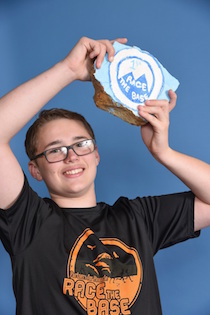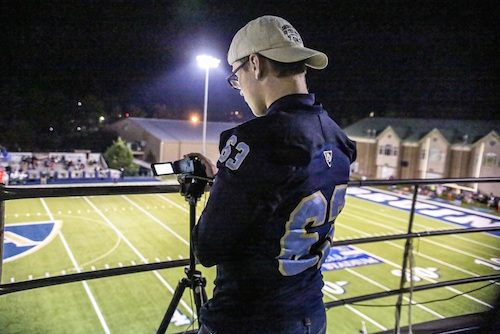‘Stomach pacemaker’ surgery allows Arkansas teen to savor life – and pizza – again
Updated: Video added Dec. 27, 2016.
DALLAS – November 11, 2016 – Hunter Pye, 16, was a high school football player, a wrestler, and strong in academics as well. Life was rockin’ along great for the Little Rock teen – but then everything changed.

“I don’t feel too good, Mom,” he told his mother Jenny Pye as they were headed to a wrestling tournament in northern Arkansas on Feb. 5 of this year. He was feeling nauseated. Thinking it was because he hadn’t eaten for hours, they stopped at one of Hunter’s favorite pizza restaurants. But the meal made his nausea worse.
It was the start of a pattern of intense daily nausea and vomiting that continued for months, causing Hunter to lose 20 pounds and seizing the joys from his life. The illness interrupted school as he struggled to manage constant bouts of nausea and endured a series of doctor’s appointments and medical tests. None of it helped. The family eventually headed to Dallas for help, finally finding relief when UT Southwestern Medical Center physicians took the unusual step of implanting a medical device called a gastric electrical stimulator. The stimulator, sometimes referred to as a “stomach pacemaker,” prompts Hunter’s stomach to empty at regular intervals as it should.
It was the first time this device, which is FDA-approved for use in adults, had been implanted in a pediatric patient in North Texas.

“We had to get an FDA humanitarian device exemption to do the surgery, but we’re so glad we did,” said Dr. Rinarani Sanghavi, Associate Professor of Pediatrics at UT Southwestern, who directs The Neurogastroenterology and Pediatric Gastrointestinal Motility Program at UT Southwestern Medical Center/Children’s Health, ranked by U.S. News and World Report among the top programs in the nation. “He woke up from the procedure and he had a pizza and a soda and he felt just fine. It was the first time in months he could enjoy something so simple and normal.”
A stubborn stomach valve
Hunter’s condition is known as gastroparesis (paralysis of the stomach). In patients with this condition, the stomach takes too long to empty its contents, causing heartburn, nausea, vomiting, bloating, weight loss, and pain in the upper abdomen. It’s often a complication of diabetes, but also can occur in otherwise healthy individuals, like Hunter, according to the National Institute of Diabetes and Digestive and Kidney Diseases (NIDDK), part of the National Institutes of Health.
Because gastroparesis is rare, it can be difficult to diagnose. Hunter, for example, was told he might have whooping cough because his severe acid reflux was causing him to cough.
Treatments can include medications; dietary changes, such as an all-liquids or pureed diet, erythromycin; and botulinum toxin, which is used to keep the valve at the bottom of the stomach in a permanent open position.
“We tried medications and we tried Botox injections to the pyloric valve so the stomach would stay open and gravity would cause food to move through. But his nausea persisted,” said Dr. Sanghavi. “It is was time for something bolder.”
The gastric electrical stimulator – a small, battery-operated device that weighs less than 2 ounces – is implanted in the abdomen with two wires connected to the lower part of the stomach.

“The device delivers an electrical stimulation to the stomach to make the stomach empty better than it does, just like a heart pacemaker delivers electricity to the heart to make it beat better. It’s the first time anybody’s done this here, but it was pretty straightforward,” said Dr. Steve Megison, Professor of Surgery at UT Southwestern.
Dr. Megison implanted the device in Hunter just below his ribs on his right side. Hunter has three small incisions to show off.
Picking a life back up
The surgery “was like flipping a light switch,” said Hunter’s father, Glen Pye.
The teen, who at one point had missed two straight weeks of school and hadn’t been enthusiastic about anything for months, suddenly had a life he was eager to get back to.
“Not long after the surgery, his mom and I were in one room and Hunter was in another. We heard him laughing at something on the TV and we turned to each other and smiled. It had been so long since we’d heard that laughter,” his father said.
With Thanksgiving just around the corner, he said he’s looking forward to celebrating the holiday with his family, along with some of his holiday favorites, including his mom’s wild turkey and his grandmother’s chocolate-filled fried pies.
“I can really describe the feeling of being back to myself as euphoria,” Hunter said.
Though he feels great again, life isn’t 100 percent back to normal for Hunter. He can’t play football anymore because a hit might break loose a wire from the device. But the football team, and especially the coach, Kevin Kelley, have been supportive. He has a new role with the team these days: filming the games.

“Before now, young patients who’ve needed this surgery had to go somewhere distant to get it done,” said Dr. Megison, who completed his residency and a fellowship at UT Southwestern before joining the Division of Pediatric Surgery. “Thankfully it’s a rare thing to have to treat, but now that we the capability here, the few patients that need it can stay in the area. It’s much easier to have your operation done locally than to travel across country.”
“It’s important to be willing to look at novel therapies to help a patient in need,” agreed Dr. Sanghavi, who also completed a pediatric fellowship at UT Southwestern before joining the faculty. “In addition to his physical problems, Hunter was feeling a lot of stress, so we are thrilled to have been able to make such a difference.”
As for Hunter, he’s staying as active as he can – which is strikingly active by any standard. He lifts weights at school and last month he won first place in the “Under 19 Division” in a 4-mile cross-country “Race the Base” trail race around Pinnacle Mountain near Little Rock. He’s hoping that at some point the gastric stimulator can be removed and he can resume participating in football and wrestling.
In the meantime, he’s decided that he wants to talk publicly about gastroparesis, letting others who have this rare condition know that they are not alone.
“The support I’ve gotten from people has been outstanding,” said Hunter. “Now I want to help other people.”
About UT Southwestern Medical Center
UT Southwestern, one of the premier academic medical centers in the nation, integrates pioneering biomedical research with exceptional clinical care and education. The institution’s faculty includes many distinguished members, including six who have been awarded Nobel Prizes since 1985. The faculty of almost 2,800 is responsible for groundbreaking medical advances and is committed to translating science-driven research quickly to new clinical treatments. UT Southwestern physicians provide medical care in about 80 specialties to more than 100,000 hospitalized patients and oversee approximately 2.2 million outpatient visits a year.
###
Media Contact: Cathy Frisinger
214-648-3404
Email
To automatically receive news releases from UT Southwestern via email,
subscribe at www.utsouthwestern.edu/receivenews
How a gastric stimulator works
- A gastric electrical stimulator is used to treat unrelenting nausea and vomiting caused by problems with the stomach muscle.
- The device, which is 2.2 inches high and 2.4 inches wide, is implanted under the skin and two leads are attached to the lower stomach.
- The stimulator delivers a mild electrical pulse to the antrum, or lowermost part of the stomach, which causes the muscle to contract.




